SEMI-SENSELESS DRAWING MODULES #3 – Portraits
抽象画を描くドローイングマシンとして設計されたSDMだが、《SDM3-Portraits》ではノイズやエラー、偶発性といったテーマの下、具象画を描くマシンとしてモジュールを再設計。NTTインターコミュニケーション・センター [ICC] にて開催された「オープン・スペース2015」(2015年5月23日 - 2016年3月6日)にて、会期中に作者二人のポートレイトを描かせることを試みた。
基本設計はSDMをベースにしているためプロッターとしては不完全な機構であり、具体的に描くモチーフを設定していながらも、その図像に向かっていく過程で生まれる機構的エラーを嫌が応にも取り込むことになり、偶発性を顕在化させる。展示空間にはカメラを仕掛け、コンピューターがプロジェクションされた作者二人の動画をリアルタイムに見ながら絵を描く構造を取り入れた。それは、鑑賞者もカメラに映り込む余地を与え、さらなる不確定要素を取りこむことになる。
共同制作者:菅野創
SDM was designed as an abstract drawing system, but artists redesigned it for representational drawing in theme of noise, error and contingency for “SDM3 - Portraits”. It drew a portrait of us two in exhibition “ICC Open Space 2015” (from 23rd May 2015 to 6th March 2016).
Since the basic design is based on the previous work, it is an incomplete mechanism as a plotter. While it sets a motif to draw concretely, it takes in systematic errors whether willing or not in the process of its heading to the icon and a contingency becomes actual. In the exhibition space a camera is set and a computer is equipped with a system to draw a portrait while watching video of two artists who are being projected. This gives the audience an opportunity to appear on the camera and adds further uncertain elements.
Collaboration with So KANNO
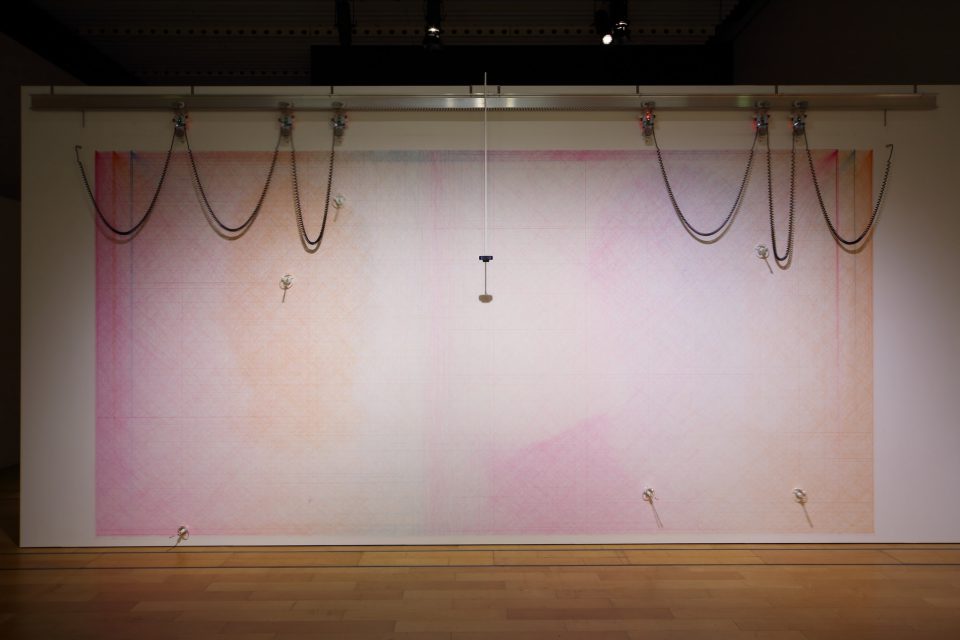
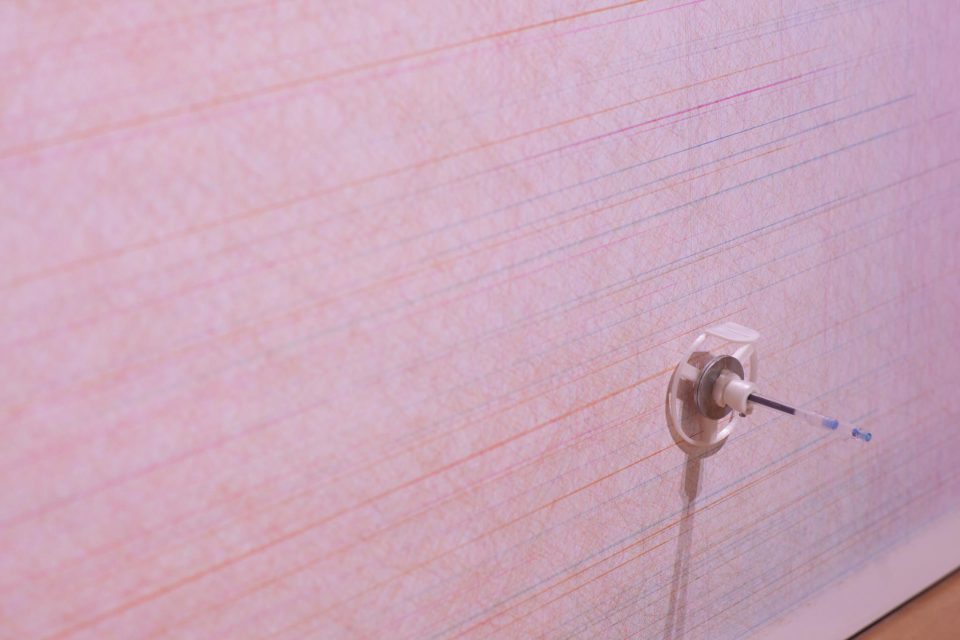
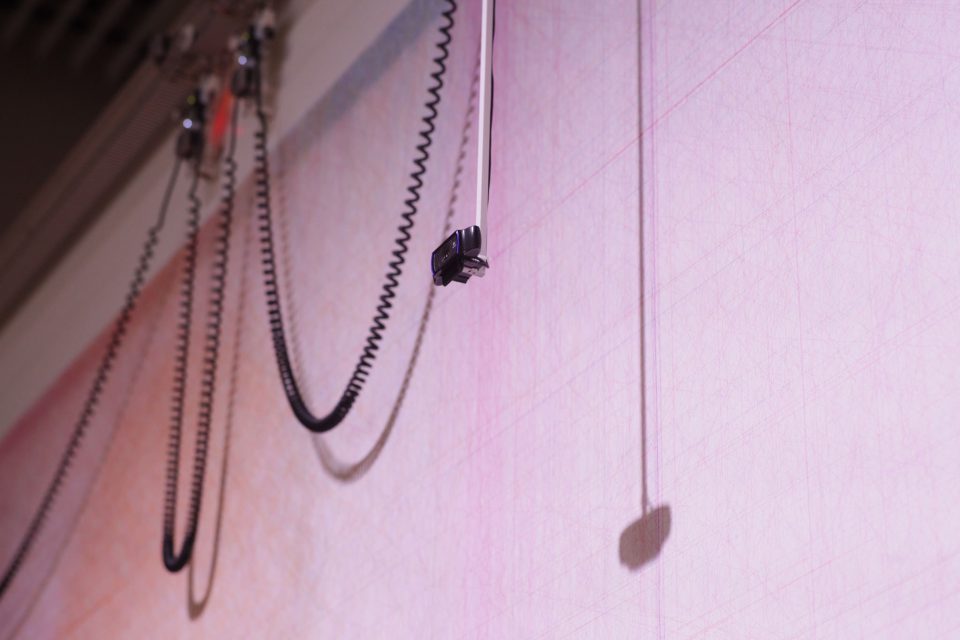
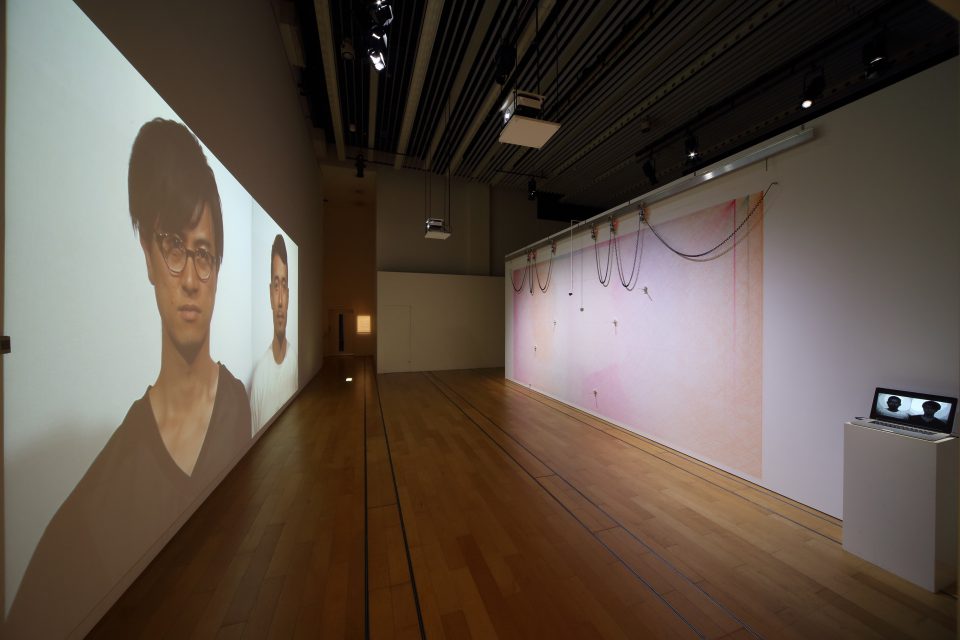
Installation view @ICC “Open Space 2015” photo by Keizo Kioku
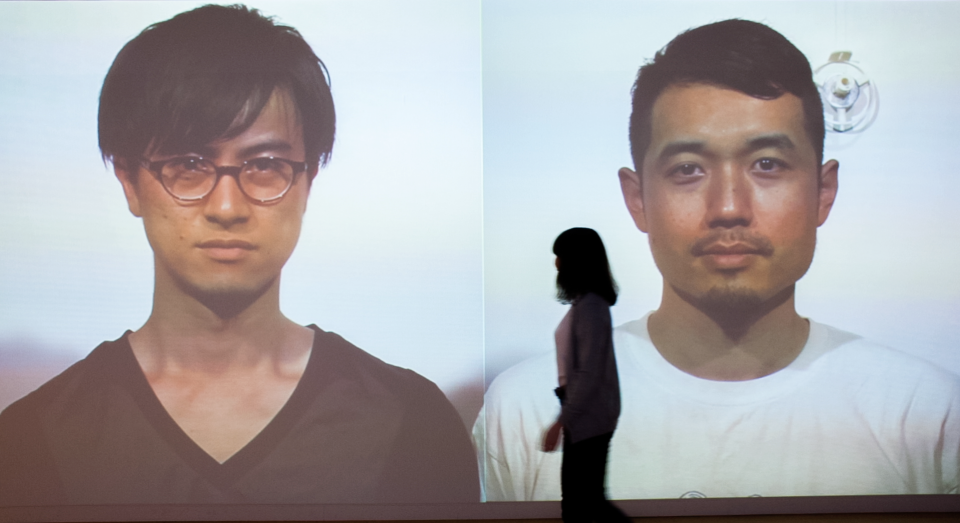

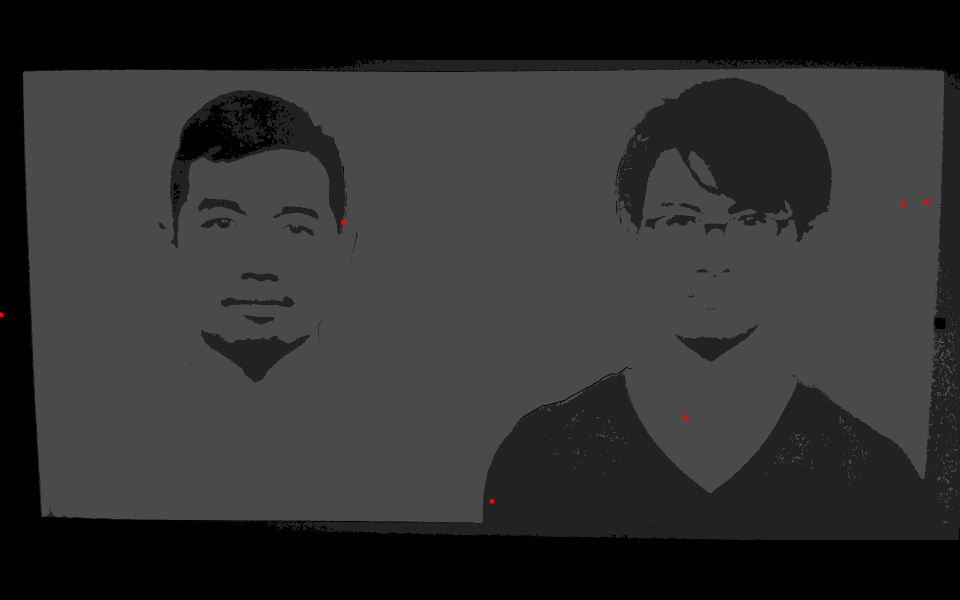
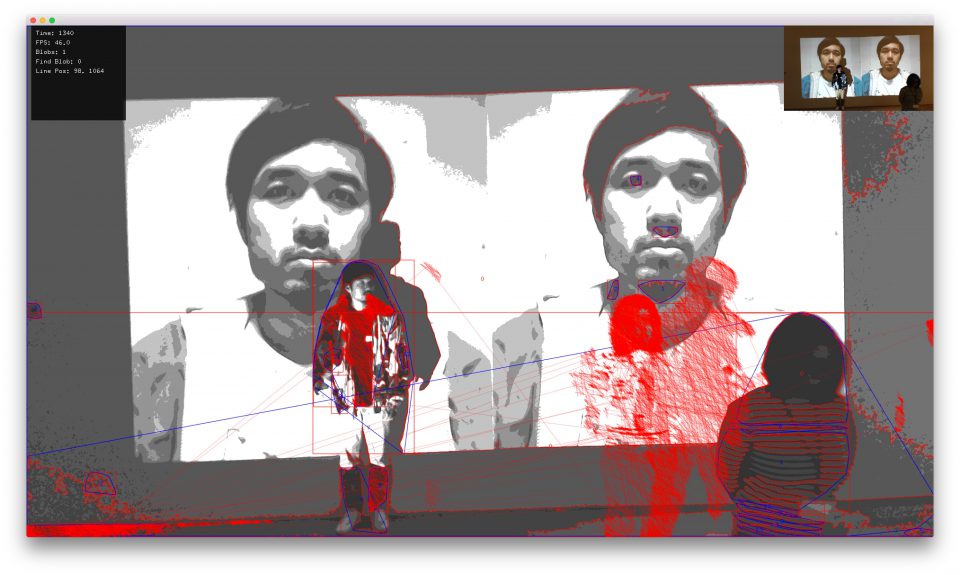
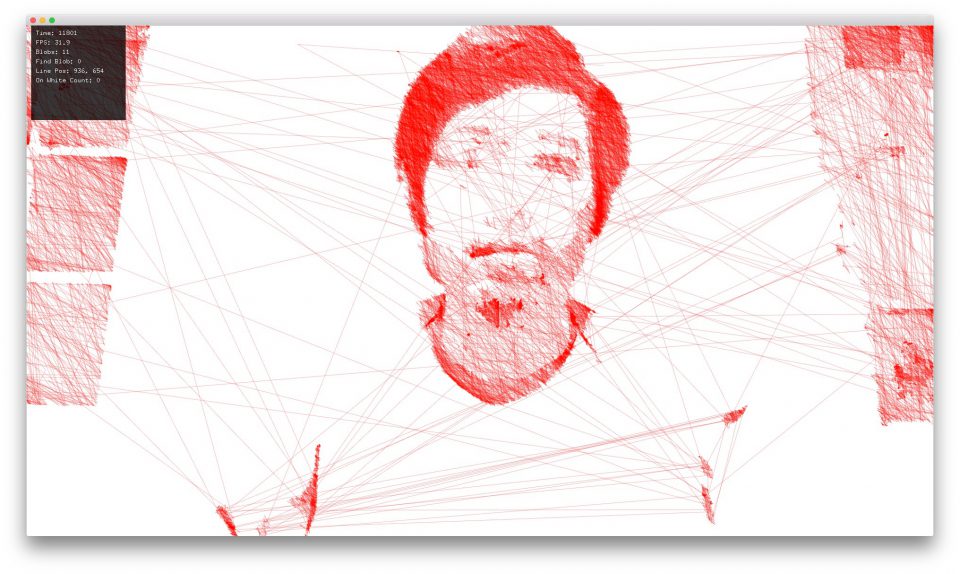
Screen shots of development
System Diagram
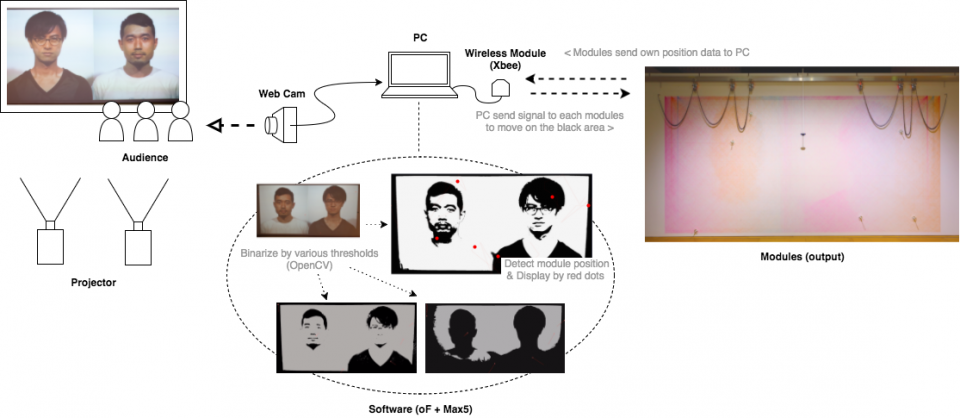
描画壁手前に設置されたウェブカメラによって、コンピューターに取り込まれた作者のポートレートや鑑賞者の像をコンピューターヴィジョン(openCV)で解析し、カラー画像を白と黒の2色にする。モジュールはこのイメージを参照しながら描画を行う。二値化画像に処理する頻度は5〜10分に一度程度。これは人間が描く対象だけを見続けて絵を描くことが不可能で、対象を目で見て脳内に保持し、その静止した脳内イメージを参照しなが描くことを繰り返して絵を描いていく仕組みと同様である。画像を二値化する閾値は10段階あり、日替わりで変化する。モジュールは二値化した画像の黒い部分だけを移動するよう、PCから無線で命令を送り続ける。
Computer makes binalized image by openCV that analyzes the image from webcam which capturing artists and spectators. Drawing modules’movement are base on this image.
Computer binalizes image every 5-10 minutes, it’s alike human painters cannot draw when he/she only sees subject. Painters see subject in a moment and keep images in their brain and draw on canvas and repeat it. There are 10 thresholds for binalization, and System changes it everyday. System manipulates modules’ position to keep inside of black area from binalization.
Concept (Background)
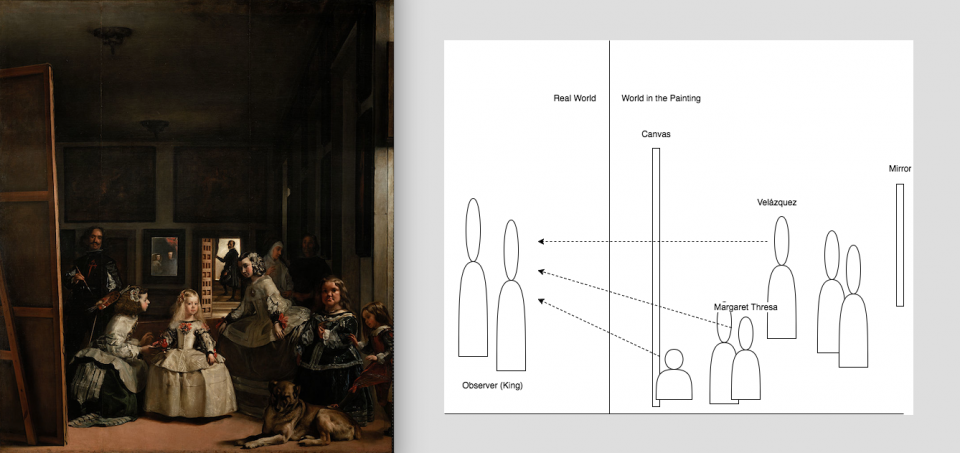
本作は偶発性をテーマにしつつ、作品の空間設計及び美術史との接続を試みるため、1656年に画家ディエゴ・ベ ラスケスによって描かれた「ラス・メニーナス」という絵画を参照している。
■自画像/肖像画
世界三大絵画の一つと呼ばれているこの絵画は、当時のスペイン国王フェリペ4世の娘である皇女マルガリータを中心とした、国王一家の集団肖像画であるとされている。しかし、この絵を描いたベラスケス本人も王族の一人として描かれていることから、当時決して高い身分ではなかった画家、彼自身が芸術家として自律した自我を持つ存在であることを誇示した自画像だという見方もある。SDM3では、作家である私たちは自ら絵を描かず機械を制作し、その装置が作家や映り込む鑑賞者の像を描く。自我のない、ある程度自律的に振る舞う機械を、当時でいう「画家」とらえると、描かれる作家の図像は肖像画ということになるが、やはり作家自身が制作した装置やアルゴリズムによる結果と解釈すれば自画像ということにもなり、どちらとも取れるといった曖昧な状況はラス・メニーナスと重ねられる。
■空間設計
絵画の中で、奥の鏡には国王と女王が写っていることから、ベラスケスの前に立ってるキャンバスの向こうには王が直立しており「画家が王の肖像画を描いてるところ」という状況設定がこの絵の一般的な解釈になる。鑑賞する側に立ってみると、鑑賞者の視線は鏡に写る王の視線と一致する。そして絵の中の登場人物たちの目線はこちらに向けられており、あたかも自分が王であるかのように絵の中に入り込み鑑賞できるという。この入り組んだ複雑な視線の構造と空間設計をSDM3のインスタレーションに応用できないかと考え、描画壁面の反対の壁に鏡対象となる私たちのポートレートをプロジェクションし、ライブカメラを用いてその像を見ながら描く構造を取り入れ、鑑賞者を絵の中に入り込ませる隙を設けるなどして、複雑な視線と空間の構造を取り入れようとした。
Main theme of this work is about contingency. But also it refers to painting “Las Meninas” by Diego Velázquez on 1656 to connect to the art history and for space design.
■Portrait / Self-portrait
The picture, which is called one of the three greatest paintings in the world is said that the collective portrait of the royal family centered on Margaret, the daughter of King Philip IV of Spain. However, Velazquez himself, the painter of this picture, was painted as one of the royal family, there is also a perception that it is a portrait that flaunted that Velasquez himself was the existence with a self-controlled ego as an artist in spite of an artist with humble social position at that time.In SDM3, we, the creaters, did not paint, but fabricated a machine which depicts figures of creators and viewers reflected to it. When we apprehend the machine that runs in an autonomous way to a certain extent as a “painter” at that time, the icon depicted can be a portrait. At the same time, it may be a self-portrait when we understand it as a result of the equipment created by creators or algorithm. This ambiguous situation that we can understand in both ways can be overlapped on Las Meninas.
■Space Design
On the painting, king and queen are reflected on rear mirror, so general understanding of situation on this painting is that the king stands behind canvas, and “the painter is painting a portrait of the king”. If we stand on observer’s side, observer’s eyes match the eyes of the king in the mirror. Additionally, characters on this painting put their eyes on our side so you can feel as if you are the king on the painting. We thought about how to apply this complicated structure of eyes and space design to SDM3 installation, then we projected our portraits reflected in the mirror on the other side of the painted wall, implemented structure to paint looking at it using live camera, set space for observers to be fused into the painting in order to combine complex eyes and space structure.
Related Exhibitions
- 2018|TRACE @New Media Gallery(カナダ,バンクーバー)
- 2015|文化庁メディア芸術祭富山展「トヤマウォーカー」 @富山市ガラス美術館(富山)
- 2015|ICC オープン・スペース 2015 @NTTインターコミュニケーション・センター [ICC](東京)
- 2018 | TRACE @New Media Gallery(Vancouver, Canada)
- 2015 | "Toyama Walker" Japan Media Arts Festival in Toyama @TOYAMA GLASS ART MUSEUM(Toyama, Japan)
- 2015 | ICC Open Space 2015 @NTT Inter Communication Center [ICC](Tokyo, Japan)